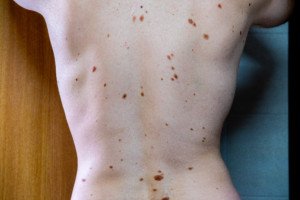What are the variables that can dictate length of time for checking your moles for melanoma?
Doing mole checks can become obsessive for those with health anxiety or who know someone with melanoma.
“I highly recommend performing regular self-exams for any changes in moles or other pigmented patches on your skin every three to six months,” says Cameron K. Rokhsar, MD, a double board-certified dermatologist and owner of New York Cosmetic, Skin & Laser Surgery Center.
You may have read that the skin cancer self-exam should be done on a monthly basis.
“Once a month for self-exams is perfectly okay as well,” says Dr. Rokhsar.
For some individuals, once a month could feel like too much work, especially if they have many moles.
It’s also possible that with monthly checks, you’ll notice new, but benign, spots that would’ve went away after a few weeks or so.
Discovery of these benign “new spots” can cause a lot of anxiety in some individuals.
For instance, a very tiny scab, also called a hemorrhage by dermatologists, can easily pass as a new, dark mole.
Nevertheless, find out what interval works best for you – not just physically but psychologically.
This may actually be every month, or, it may be once every two or three months, or twice a year.
Keep in mind, though, that if you commit to monthly exams, you may find this easier to adhere to.
And if you think that any schedue of skin self-exams is a hassle, imagine the hassle of chemotherapy infusions for a melanoma that was diagnosed at a late stage.
When melanoma is caught very early, the treatment is only surgical excision, followed by close surveillance for the following 12 months.
“I also recommend a skin cancer screening by your dermatologist at least once a year,” says Dr. Rokhsar.
Even if your health insurance doesn’t cover the cost of a skin cancer screening, you should not let that stop you.
A screening by your general practitioner, squeezed in during your annual physical that’s covered by your medical plan, should NOT replace a more thorough screening by a dermatologist who’s trained to notice suspicious lesions.
Furthermore, a dermatologist will use a handheld device, a dermatoscope, to view your moles.

Dermatoscope. Shutterstock/LightField Studios
Length of Time Looking at Moles for Melanoma Checks
“The length of time it takes to check a mole during a skin exam can vary depending on the size, shape and location of the mole,” says Dr. Rokhsar.
“However, a typical skin exam usually only takes 20 minutes or less.”
If you have many moles, of course it’s going to take longer.
You should take more time inspecting large, irregularly shaped moles.
If your dermatologist has diagnosed these as atypical, also known as dysplastic nevi (singular: nevus), you should take a little extra time to make sure they aren’t looking darker, bigger or otherwise different than usual.

Many dysplastic nevi or atypical moles. Shutterstock/Mikel Ugarte Gil
There is no handbook or protocol on how many seconds you should spend looking at any type of mole, whether the time spent is based on a certain size (e.g., the diameter of a pencil eraser), location such as the face, or if the mole has always looked different from all your other moles.
You’ll need to use common sense. For example, you’ll want to spend longer looking at the moles on your back since you can’t get up close to them.
If your close-up vision is compromised, you’ll want to use reading glasses.
For some people with crummy up-close vision, their moles – even ones on their arms directly in front of them – will look like blurry spots.
It won’t be possible, then, to notice early malignant changes if the spot is blurry due to poor vision.
You should establish a new baseline with reading glasses.
You may become nervous upon seeing details in the moles due to the magnification.
It will greatly help ease your anxiety if you perform your self-exam shortly before getting an exam by a dermatologist.
If your dermatologist says everything looks great, you can then breathe a sigh of relief that all those “new” details are normal – and that will be your new baseline for subsequent self-exams.
It’ll also help to get to know each mole — or at least, the biggest ones or the ones that are easiest to view — and even name them based on their shape or color pattern.
Then, each time you view that mole, you know that its “pear” shape or “two tone” color is par for the course.
If you think a mole looks different, it can be tempting to spend a large amount of time studying it. Instead, make an appointment with your dermatologist.
For moles that do not appear to be changing, you don’t want to get into the habit of viewing each one for too long.
Again, there is no clearly defined viewing length for a mole that has been established. Use your common sense.
- Inspect your moles in the same area of your home every time.
- Make sure there’s a very good light source.
- The time of day should be the same, too, to minimize variations in natural lighting and shadow.
- Use a hand mirror for assistance.
“For those with health anxiety or who know someone with melanoma, mole checks can become obsessive or anxiety provoking,” says Dr. Rokhsar.
“Regular skin checks, along with professional evaluations by a dermatologist, can help identify any potential problems early on.”
 At New York Cosmetic, Skin, and Laser Surgery Center, Cameron K. Rokhsar, MD, FAAD, FAACS, and his team provide exceptional skin care solutions for many conditions and skin diseases including all types of skin cancer. Dr. Rokhsar is board certified in dermatology and dermatologic surgery.
At New York Cosmetic, Skin, and Laser Surgery Center, Cameron K. Rokhsar, MD, FAAD, FAACS, and his team provide exceptional skin care solutions for many conditions and skin diseases including all types of skin cancer. Dr. Rokhsar is board certified in dermatology and dermatologic surgery.
 Lorra Garrick has been covering medical, fitness and cybersecurity topics for many years, having written thousands of articles for print magazines and websites, including as a ghostwriter. She’s also a former ACE-certified personal trainer.
Lorra Garrick has been covering medical, fitness and cybersecurity topics for many years, having written thousands of articles for print magazines and websites, including as a ghostwriter. She’s also a former ACE-certified personal trainer.
.


























